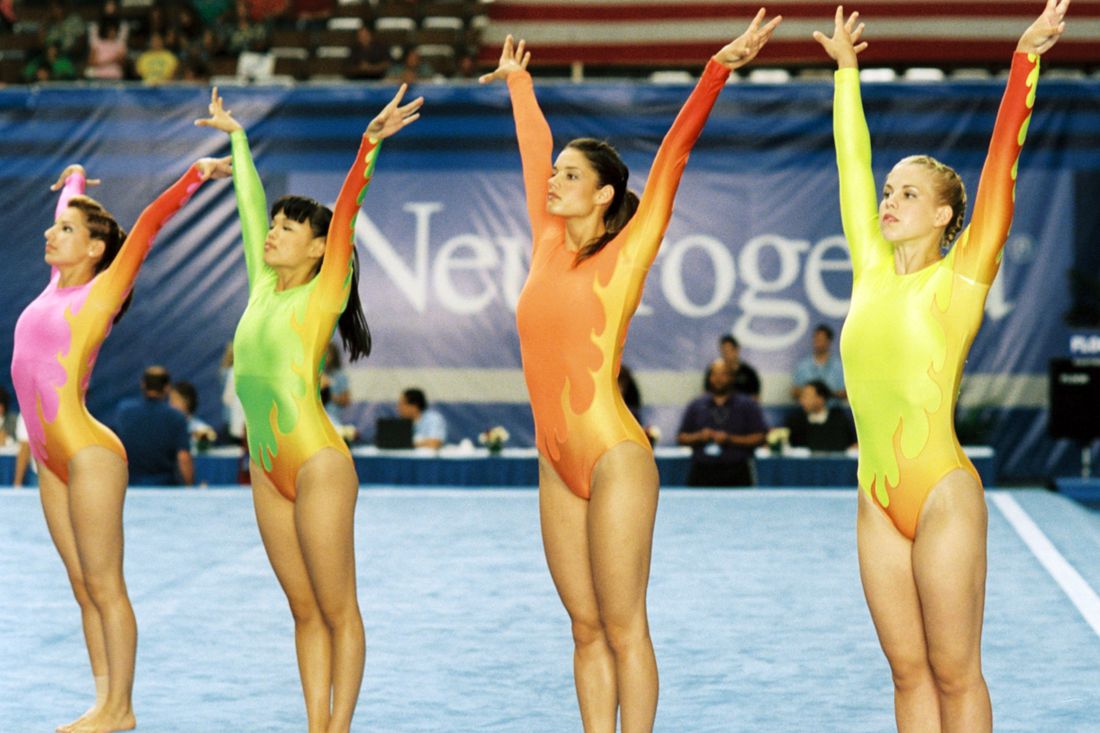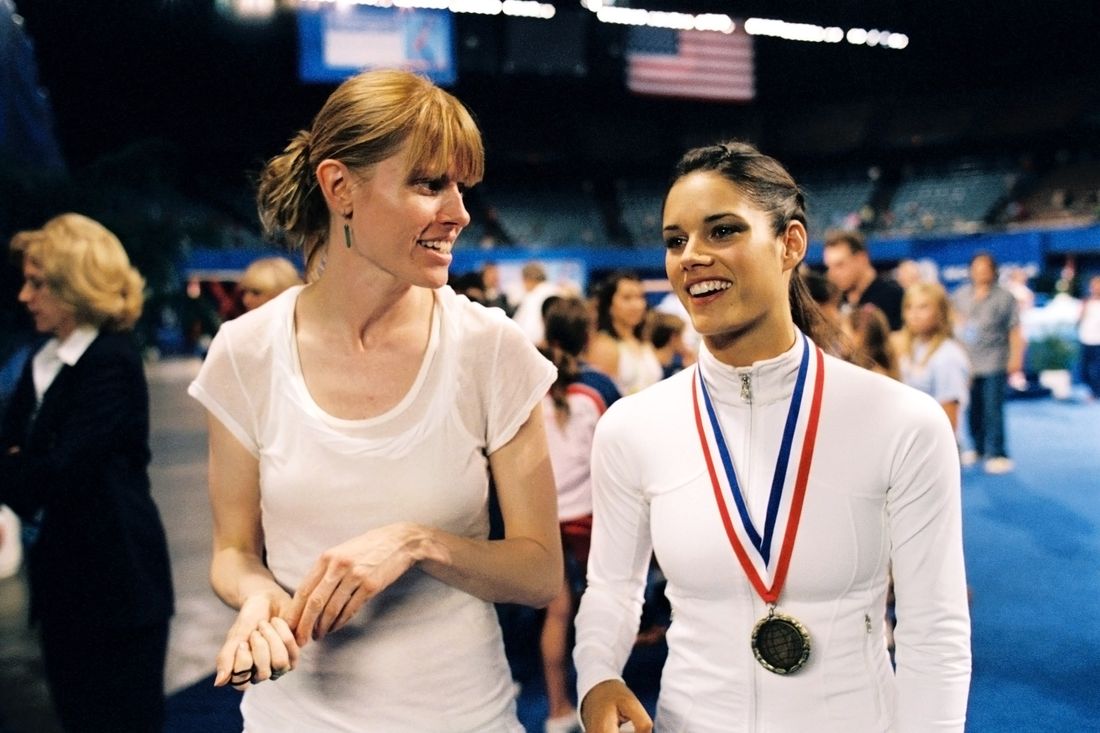
As a former gymnast who has walked the tightrope of the sport, I can wholeheartedly relate to the raw emotions and struggles portrayed in “Stick It”. The vault, that cold, unyielding obstacle, mirrors the inner demons we all face in our personal journeys. It’s a testament to resilience, defiance, and the human spirit’s ability to heal and grow.
In 2006, two movies bravely presented unconventional narratives using dance as a medium. The first was “Happy Feet,” initially appearing to be a heartwarming penguin story, but it subtly transformed into a powerful message about pollution and overfishing. The second was “Stick It,” a gymnastics-centered comedy-drama that inspired athletes to challenge the current judging system. Both films are remarkable pieces of artistry. Given it’s Olympics season, let’s delve into the one with the chalk – “Stick It.”
Six years after penning the influential sports film “Bring It On,” Jessica Bendinger directs the high-energy movie “Stick It.” The story follows Texas teenager Haley Graham (Missy Peregrym), who is reluctantly thrust back into the realm of elite women’s gymnastics due to a court order following an arrest. Despite her exceptional abilities, Haley would prefer military school over gymnastics. However, coach Burt Vickerman (Jeff Bridges) gives her a chance at his academy. Throughout the first half of the film, Haley gradually rekindles her passion for the sport that didn’t always reciprocate her feelings. Eventually, she and three teammates qualify for nationals, but they remain unaware of why Haley abandoned the World Champions a year ago, a decision that cost Team USA its gold medal.
That intrigue dissipates fast, however, when The Man gets involved. The judges are on a hot streak of asshole-ness, deducting points across all gymnasts for the most trivial reasons. “It doesn’t matter how well you do,” Haley narrates in one scene, “it’s how well you follow their rules.” And then, a defiant breaking point: When one of her teammates loses out on a perfect vault score because her bra strap was showing, Haley decides to stage a rebellion where all of the gymnasts, in solidarity, “scratch” their routines to choose the winner themselves in the four apparatuses. It’s about them, for them. They’re done being obedient to an archaic and broken system.
In a twist of events that hadn’t occurred in real-life sports before, Bendinger, an ex-gymnast, strongly supported this idea after recognizing it could create a clearer antagonist – though some movie producers found her concept hard to grasp at first.
It’s incredibly fulfilling to know that I made the one iconic gymnastics film. Seeing younger gymnasts mimicking jokes from it and seeing its impact on gymnastics culture is amazing. If you were a passionate fan of gymnastics as a child, it’s inspiring to see athletes acknowledging something you created. Moreover, it sparked important discussions early on in the gymnastics community – if someone was working in this field, they needed to be aware of Stick It. There’s no other movie quite like it, and I’m confident that anyone who values human achievement can’t watch it without thinking, “This is not an unjust system.” Teamwork and collaboration have always played a crucial role in overcoming challenges.
In the movie Stick It, the narrative focuses on Haley’s transformation until the third act shifts to address deeper systemic problems. How did you come up with the concept of a gymnastics revolution? As far as I know, this has never occurred in an elite competition.
1. In questioning my own thoughts, I arrived at that realization.
The concern that we had was whether the scenes with the bra-snapping were too exaggerated or not. We weren’t sure if it would be too much or too little when blown up for the screen. If it was too much, it could become cartoonish, but it still needed to deliver effectively. Fortunately, Missy managed to convey a hint of rebellion in her lines, which helped me balance vulnerability, anger, and maintaining a lovable character despite creating quite a stir. This rebel character transforms into a renegade working for the greater good, adding an element of surprise since this transformation isn’t immediately apparent in the movie, but is present from the start.
Were you able to make clear your intentions behind this shift in storytelling? It seems that the studio struggled to grasp it, which led them to sell the negatives for ‘Stick It’ three days before production on our project started, in order to finance ‘Pirates of the Caribbean 2 and 3’. They were financially strapped and sold those negatives to Spyglass. We discovered this due to an informant within the studio. The executives at Disney behaved unacceptably, behavior that would be considered unprofessional today. Female executives were overly defensive, while the male Head of Marketing opted not to promote the movie because his rival Head of Production had sold the negative to Spyglass. I was taken aback by such conduct persisting for so long. In other words, it seems they failed to understand your objectives with this narrative change.
In our initial focus-group test in California, the project scored exceptionally high across all categories, which is quite unusual. The Disney executives were taken aback by this result. The head of production then approached me and cautioned, “This could be a misleading positive; don’t get too excited.” It was surprising to see her express such pessimism following such an impressive success. High scores like these from focus groups aren’t common. This is the situation we found ourselves in.
There’s a certain irony, don’t you think? The people at the studio might have reacted defensively because they were portrayed negatively in the film. A movie executive is much like a gymnastics judge – no risk, no actual work, yet with excellent salary and benefits. On the other hand, it’s the creatives and actors who bear all the risks, taking the blame when things go wrong. It’s almost absurd that they judge us, isn’t it? Watching such behavior was painful and disheartening. It felt like they had forgotten their humanity. I refused to play along. I won’t bow down if there’s nothing worthy of respect.
As a fervent admirer of gymnastics, I pondered over the reasoning behind my passionate commentary when a gymnast’s visible bra strap resulted in a deduction of points. The reason it resonated so deeply was because it seemed to epitomize an unfair technicality that, in a way, reflects societal expectations towards women.
In 2012, Gabby Douglas faced criticism for the appearance of her hair after winning the all-around gold medal at the Olympics. This incident served as a reminder of how such attitudes can permeate society, particularly on social media platforms. It’s hard to believe that people could pass judgment on her, given she had just achieved such a remarkable feat. It’s astonishing and disheartening, but unfortunately, it’s reality. The idea that they thought they had the audacity to comment in such a manner is bewildering to me. I suppose we should continue striving for progress, America.
In my opinion, I wanted to echo Haley’s initial rebellious spirit, symbolized by her vaulting move in the gym, flipping off both the establishment (gym and coach) with a defiant middle finger. From a narrative standpoint, it was powerful and healing – showing how she transforms from an insubordinate character into someone who’s healed and reclaiming her power by the story’s end. It’s like saying, “I’m not doing this for them, I’m doing this for us.” Moreover, the vault is a challenging apparatus, as we saw with Simone Biles’ experiences at the Tokyo Games. As an ex-gymnast, I couldn’t help but share that dread and dislike for it.
Charging headlong at an immovable obstacle can be seen as a sign of madness. For me, it’s a powerful symbol of the aspects within us that we struggle to change and the narrative behind it. The goal is to conquer that resistance. It doesn’t yield; it simply exists. Your internal oppressor is so aptly personified by the vault. It symbolizes that persistent part of each of us that we strive to surpass. It’s a simple construct. The bars, floor, and beam are more complex, but the vault…it just feels overwhelming.

As a movie reviewer reflecting on the film “Stick It,” I can’t help but draw parallels between the struggles portrayed on screen and the real-life experiences of young gymnasts. The movie captures the intense pressure and high expectations that these athletes face, particularly in terms of conformity and obedience. This is a theme that was painfully evident during the Larry Nassar scandal, where many gymnasts were forced to comply with unimaginable demands at a young age.
As a former competitive gymnast myself, I’ve seen the highs and lows of this sport firsthand. The movie has sparked a lot of conversation about the judging system, and I find myself pondering over whether the judges themselves have taken a closer look at their roles in the process. It’s been heartening to see improvements in scoring and clarity since its release, but I can’t help but wonder if it was the movie that inspired those changes or simply a natural progression in the sport.
In essence, the film “Stick It” aimed to depict gymnastics authentically, though as discussed earlier, such rebellion regarding scoring is unheard of in reality. Yet, it could serve as a premonition for future gymnasts. If you’re wondering if they should control the results, I’d say it’s more about them finding their power and using their voices to make a difference. It seems that prediction has come true, though it’s unfortunate that they had to experience collective turmoil to find their voices. The movie may have served as a guiding light for them during difficult times.
Read More
- W PREDICTION. W cryptocurrency
- ACT PREDICTION. ACT cryptocurrency
- PENDLE PREDICTION. PENDLE cryptocurrency
- Skull and Bones Players Report Nerve-Wracking Bug With Reaper of the Lost
- NBA 2K25 Review: NBA 2K25 review: A small step forward but not a slam dunk
- Mastering Destiny 2: Tips for Speedy Grandmaster Challenges
- Rainbow Six Siege directory: Quick links to our tips & guides
- Exploring Izanami’s Lore vs. Game Design in Smite: Reddit Reactions
- Overwatch Director wants to “fundamentally change” OW2 beyond new heroes and maps
- League of Legends: Saken’s Potential Move to LOUD Sparks Mixed Reactions
2024-08-01 22:59